By Kent Klewein
Spring Bass Fishing Tactics for fly anglers interested in Southern Appalachian reservoirs.
There’s tons of lakes readily available for fly fisherman to catch bass throughout the Southern Appalachian region. Unfortunately, these lakes aren’t your two-acre farm pond in your backyard or subdivision that you grew up fishing as a kid—they’re multi-thousand acre reservoirs that can be extremely challenging to learn how to fly fish.
Fly Fishing Reservoirs starts with fishing the correct areas.
Fly fishing for bass on public reservoirs is much like trying to find a needle in a haystack. If you don’t have a general idea of where the needle is located, your chances of finding it are slim to none. To be successful fly fishing lakes, you’ll have to quickly be able to eliminate areas of the lake where the bass aren’t located and then narrow your focus to small areas of the lake that provide bass what they need. Bass need the following: suitable habitat, satisfactory food and comfortable water conditions (water temperature & water depth). All these change depending on the season. In our case, we’ll be focusing on what bass need during the spring. Just like in trout fishing, bass fishing is all about bypassing unproductive water and spending your time fishing the productive water. Eighty percent of the bass on the lakes will be found in 20 percent of the water. If you want to catch them, you’ll need to maximize your time fly fishing the correct water.
A Quality map of the lake is critical
Keep in mind, all maps aren’t created equal (and many are total crap). The map you want to buy needs to have enough detail on it that you can get a clear picture of what the lake looks like underwater and what types of cover it has. Specifically, the map needs to show good contour lines from the shoreline, out into the main river channel. Contour lines are also referred to as break lines and they show you depth change. Ideally, you want a map that shows five-foot break lines, ten-foot minimum. Anything less than that and you really won’t have enough information to locate hot spots to start looking for bass, come spring. For quality lake maps for the Southern Appalachian region go to www.maps.tva.com
Study your lake map before you hit the water. Locate your main points, prime humps, flats and creek channel mouths that are located close to spawning grounds. Once you find those, search out spots where the break lines are close together. These are areas that should have lots of food, plenty of structure and a wide range of depth. The farther away break lines are from each other on a map, the longer the distance between depth change. Bass like areas in a lake where they can quickly change their depth without having to travel long distances. Bass are naturally drawn to these niche areas because they can make quick position adjustments to stay in the most comfortable water. It’s exactly like trout preferring to hold in areas that have the three C’s (cover, cuisine and current protection). Bass are no different.
Spring is a transition period for bass.
Spring brings longer days and rising water temperatures. This encourages bass to move up from their deep water winter sanctuaries into shallower water to follow their forage food and scout out spawning grounds in preparation for reproducing. The entire process of spawning requires an insane amount of energy for bass, and they’re forced to build up large fat reserves to keep them from starving and successfully reproducing. The key reason spring is one of the best times of the year for fly fisherman, is because bass are moving into shallower water and their feeding activity significantly increases. You’ve got opportunistic feeding bass located at depths where you can present your fly to them effectively.
Although spring is great all around for chasing bass on the fly, the best time by far is during the pre-spawn. This is the period where the bass are staging around the spawning grounds before they get on the beds. It generally lasts four to five weeks and can be timed by paying close attention to the water temperature on your lake. Spotted and smallmouth bass go into pre-spawn when water temperatures hover around 53-55 degrees and spawn around 57-58 degrees, while largemouth bass postpone their pre-spawn until water reaches 62-64 degrees and spawn around 65 degrees. Once the bass get on the beds, fishing is more conducive to conventional tackle. However, if your lake has all three species of bass, you can keep the fishing hot by starting out targeting the spots and smallmouth pre-spawn and then switch to targeting largemouth. This way you’re able to capitalize on the peak periods of fishing during the pre-spawn for all species. Tip: Largemouth go on the bed when the dog woods start to bloom.
Locating bass in the spring.
A mentor of mine once told me, “bass live deep and feed shallow.” It doesn’t hold true 100 percent of the time, but the majority for sure. When bass feed, they usually move up into shallower water to do so, and they do it in the spring primarily, because that’s where (and when) the most food is located in the lake. If you want to get really technical about where to look for bass, fly anglers should focus on areas of the lake that get the most sun and heat up the fastest in the spring. On really large lakes this will likely be the north side. That’s where the sun will shine on the water for the longest period of the day. Next, anglers want to look for rocky areas with large chunk rock. The rock absorbs the suns energy, and in turn, heats up the water faster than in other areas of the lake. On most of our Southern mountain lakes, rock is pretty easy to find. Unfortunately, not all rocky areas of the lake will hold equal bass numbers. Focus your efforts on fishing long rocky points tapering into deep water and rocky humps and flats adjacent to deep water on the main lake. That’s where you’re going to find your spots and smallmouth.
For largemouth, you’ll want to primarily target wood, also on points, humps and flats. But you’ll want to look for them more in the creeks’ mouths adjacent to shallow water that’s generally found on the upper part of the lake where it’s being fed. Vegetation also absorbs sun and will increase the speed as water warms up around it. If you can find it then definitely fish it, but since most of our mountain lakes are pretty deep and vegetation requires light to grow, you’ll find that it’s much easier to locate rock than aquatic weeds.
Utilizing your boat electronics is 80 percent of bass fishing.
A quick glance at a screen will tell you water depth, water temperature and whether or not bass or the food they’re eating are in the vicinity. Today’s latest GPS/sonar side and down scan imaging electronics can give you a two or three-dimensional underwater view so detailed, they’ve been used to locate people who have drowned. If you’re uneasy with electronics, hire a guide that specializes in teaching clients how to read and fish with them. Remember how many fish you caught and how much you learned when you finally broke down and hired a trout guide? It’s going to be the same story when you hire a professional bass guide. Lastly, make the investment of purchasing lake maps and navionics chips for your electronics. That way you’ll have the same detail of your map and can use them together to navigate you to the prime water. The Lowrance Elite-7X HDI and the Hummingbird 998c HD or 958C HD are some of my favorites and most advanced boating electronics out there currently. Navionics.com is a great place to outfit your electronics with the latest mapping chips, to get the most out of them.
Spring forage food and fly patterns.
One of the most important food sources for bass during the spring is crayfish. It shouldn’t be a big surprise since our rocky mountain lakes provide the perfect habitat for them to thrive. Crayfish are full of protein and easy pickings for bass. They come out of their burrows and flock to the rocky banks in great numbers once water temperatures begin rising into the 50s. A crayfish pattern should be one of your first flies you tie on when fly fishing lakes in the spring. There are quite a few good crayfish patterns out there today to choose from and all species of bass eat them. Just make sure your pattern is tied on a jig-style hook, so it rides hook point up in the water and has with it plenty of weight. That will keep your fly near the bottom where the crayfish are found, limit snagging and provide you maximum action. Because crayfish prefer rocky habitat, make sure you’re fishing them around rock cover. That’s where you’ll find them to be most effective.
The other main forage food that bass feed on heavily during the spring will be baitfish, like blue-back herring and shad. Blue-back herring have been illegally introduced on just about every one of our lakes in the Southeast. They’re great for growing big bass but they’re a double-edged sword because they also feed on bass eggs and fry. I have a love/hate relationship with them because they provide bass with an almost limitless amount of food, but they can absolutely devastate their spawning efforts. Fish baitfish patterns when you physically see bass on the water, on your electronics or when your crayfish patterns aren’t producing.
Blue-back herring school up and never really stop moving except when they’re spawning themselves, so it can be difficult at times to stay on their tail, and the bass that are chasing them. They also like open water, which will pull bass off of structure in pursuit. Before we got blue-back herring in our lakes, the bass rarely ventured far from the shoreline and adjacent deep water structure. Back then, crayfish and bream were the dominant food sources and open water isn’t where you find them. Keep this in mind if you’re striking out in shallow water. You may need to back off into deeper water or motor around until you find schools of baitfish particularly during the post-spawn. As for baitfish patterns, fly size is the most critical, followed by color. Three inches is a good starting point but pay attention to the size of the baitfish if you get a bead on them in the water. Subsurface patterns will produce better than topwater, except when it’s early or late in the day, when bass are corralling them up and busting them on the surface.
Water depth, water temperature, and wind.
Water temperature is probably the number one variable in the equation for consistently catching bass in lakes. If you’re wanting to hit the lake during the pre-spawn, wait at least until the water temperature gets into the low 50s. Before that, you’ll probably find the bass too deep for you to really be effective at catching them with a fly rod. It’s not impossible—I know striper guys who catch bass deep. It’s just more technical. The shallower the bass, the easier they’ll be to catch.
Pay close attention to what the weather is doing. A stretch of three or four days of consistent warm weather will really turn the fish on and get them moving shallow. That’s when you want to time your fly fishing trip. Find rocky points, ledges around the edges of humps and flats, and creek mouths close to spawning grounds in six to 12 feet of water. That’s a good starting point when you’ve had great weather, but if a cold front comes in, you’ll want to back off five feet or more into deeper water to follow the bass making position adjustments for the changing weather. Find a rocky point or flat that has multiple break lines and start off fishing parallel to a deep break line. Continue moving shallower toward your structure until you start getting bites. During this process, you’ll want to keep a close eye on your electronics to keep yourself fishing at your target depth and direction. When you catch a bass, make a mental note of the water’s depth and temperature. Then focus on keeping every detail of your fly fishing the same, from water depth to your fly retrieve.
Wind isn’t a bad thing either. At times, it can be your best friend. I’ve had some of my best days fly fishing for bass after there had been a couple days of consistent wind blowing in the same direction. Wind blows and concentrates food and that can create a feeding frenzy for bass. Furthermore, wind masks your position and makes bass less spooky. If you’re on the lake fly fishing and the wind picks up and holds direction, make a point to fish close to the windy points, humps and flats. You can catch the heck out of bass in those conditions. Lastly, wind can churn up and muddy water. Don’t be afraid of fly fishing muddy water. Bass have no problem with it unless they’re on the beds. In muddy water conditions, bass will move tight to cover and also more shallow. Be prepared to make repeated casts to cover, since the strike zone will be smaller. Flies with rattles are a good idea for windy and muddy water conditions because extra sound helps the bass zero in on your fly.
The Gear
I carry two different setups with me when I’m fly fishing lakes in the spring. One’s for targeting bass in shallow water and the other is for targeting bass in deep water. My shallow water rig consists of a 9’ 0” 7wt with a clear intermediate fly line. I’ll start out attaching a 7 1/2’ 3X fluorocarbon leader, but if I’m not getting bites and I’ve located bass on my electronics, I’ll switch to a 4X leader.
For my deep water rig, I use a 9’ 0” saltwater 8-9wt rod with a 375 grain sinking line. I attach a four-foot section of 3X-4X fluorocarbon tippet and tie my fly on with non-slip loop knot.
One of the biggest mistakes anglers make when fishing our Southern mountain lakes is fishing line that’s too heavy. You want to stick to the 5-8lb. range. Don’t go too heavy on your hooks either or you’ll have a hard time getting the hook to penetrate on hook sets or risk breaking off. Use about the same size hooks you use when tying streamers for trout. I’ve found 60-degree jig hooks in size 1 or 2 work well.
Get out there this spring and catch those bass on the fly.
Check out the April Issue of Southern Culture on the Fly
Keep it Reel,
Kent Klewein Gink & Gasoline www.ginkandgasoline.com hookups@ginkandgasoline.com Sign Up For Our Weekly Newsletter!
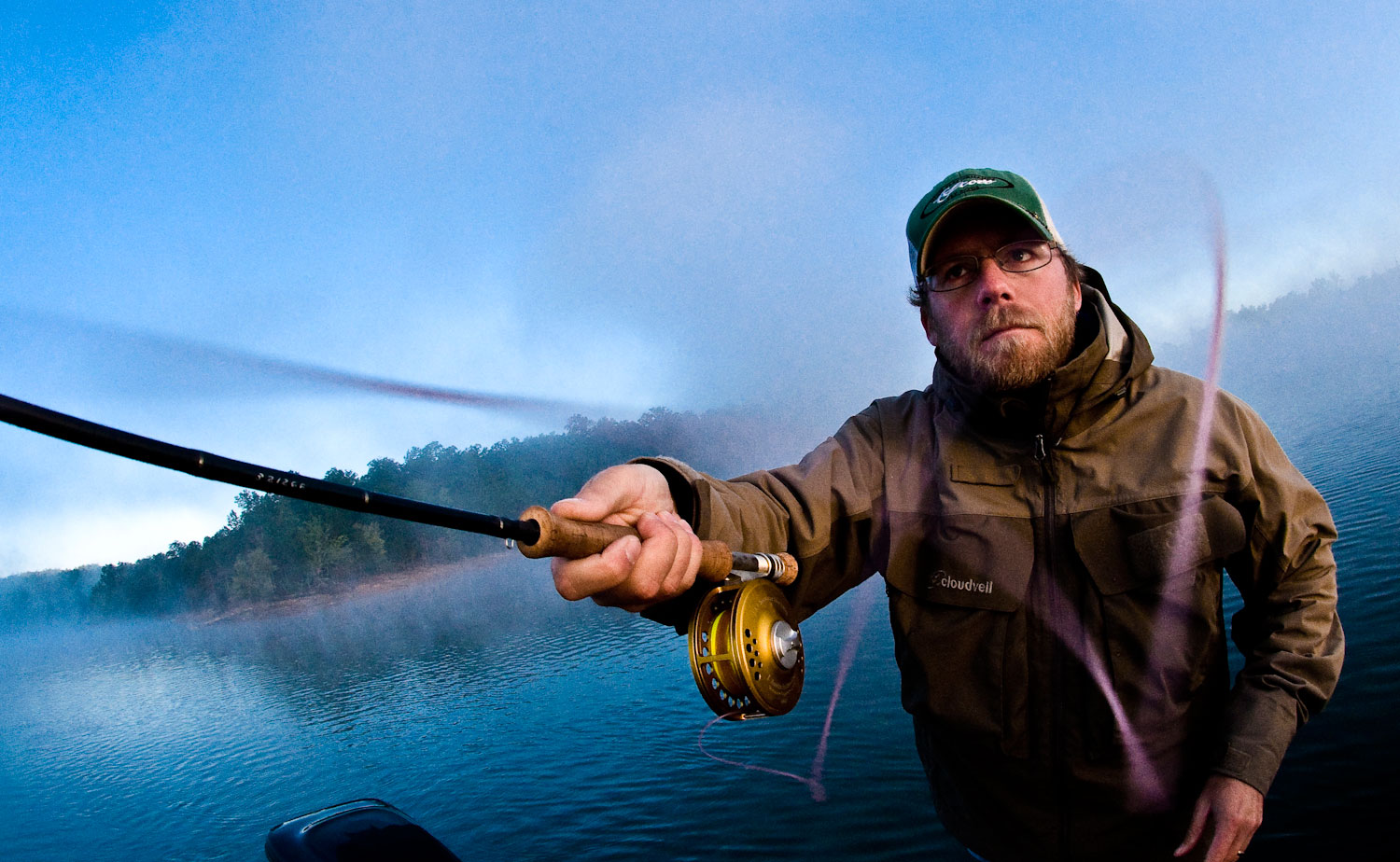
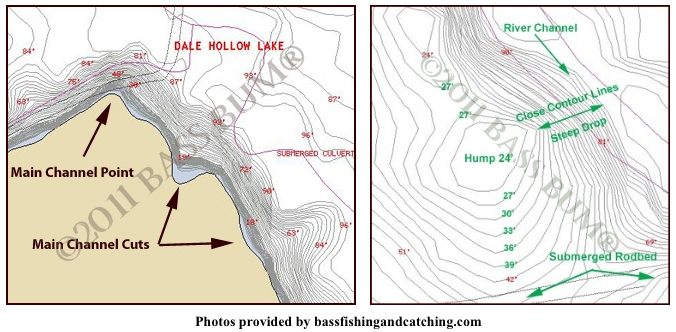
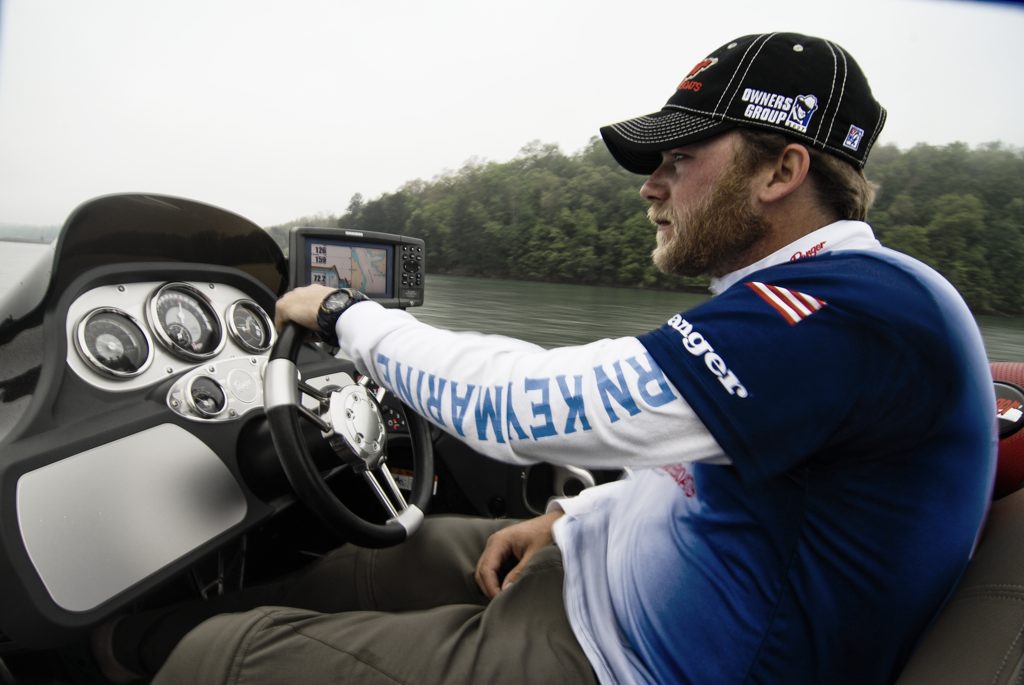

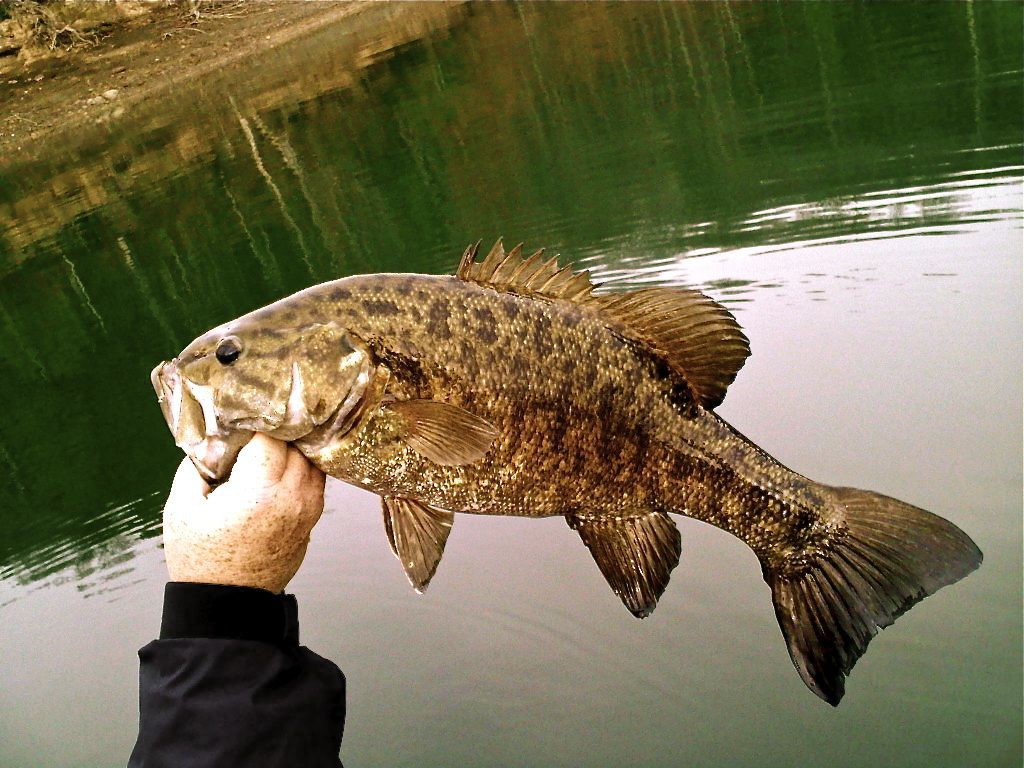
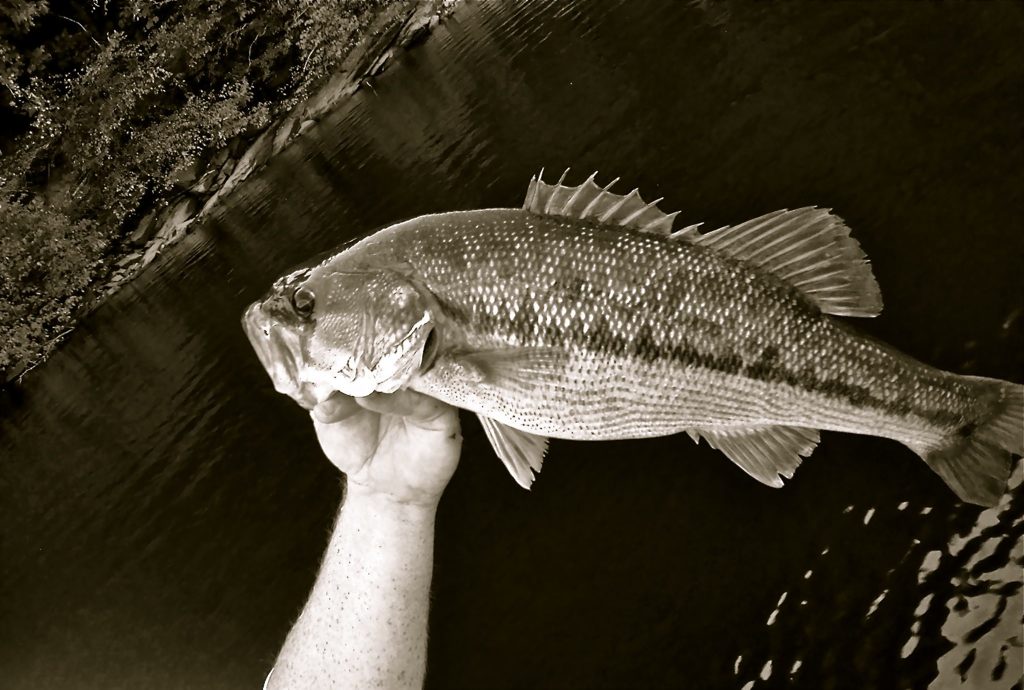
Hey Kent, great article! Here are my two cents…when you are searching for bass in a lake, use a baitfish pattern, preferably smaller and unweighted, with marabou and a pretty decently sized hook on there to act as some weight, maybe up to 4/0. The marabou will absorb water and allow it to sink, as does the line and hook, no lead or extra weight. This setup gives you versatility and ease of fishing, you can fish very shallow or a little deeper without getting tired from casting a heavily weighted fly. The heavily weighted crayfish fly will be too slow and take too much energy to cast when searching for bass. If you are not in the right place it could be a lot wasted time and energy hopping a cray. So, go with an easy to fish, unweighted batifish pattern so you can move fast and make a lot of effortless casts to find the fish. Then, when you have located the bass, throw out the crayfish and work it slowly. It is great to have multiple setups, as you mentioned, because different setups have different advantages. Great as always, Kent. Thanks.
Pingback: Southern Appalachian lakes bass fishing article. – Warmwaterflies.com